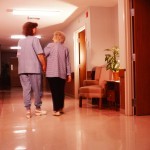Is it normal for aging adults to fall?
 A fall later in life cannot be categorized as a “normal” event solely because the adult is over age 65; there are many older adults who never experience a fall. Rather, a fall by an older adult could be discerned “abnormal” when other criterion are considered, for instance, the presence of an acute or chronic illness or adverse reaction due to a medication. As a point of comparison, it is assumed that childhood falls are, for the most part, a “normal” part of growth and development. However, incidences occur when falls are not normal, but due to a medical illness, such as a brain tumor or epilepsy.
A fall later in life cannot be categorized as a “normal” event solely because the adult is over age 65; there are many older adults who never experience a fall. Rather, a fall by an older adult could be discerned “abnormal” when other criterion are considered, for instance, the presence of an acute or chronic illness or adverse reaction due to a medication. As a point of comparison, it is assumed that childhood falls are, for the most part, a “normal” part of growth and development. However, incidences occur when falls are not normal, but due to a medical illness, such as a brain tumor or epilepsy.
Falls are a public health problem that has no geographic boundaries or age restrictions. Anyone can fall. Most individuals know of someone, if not themselves, who has fallen. In early childhood years, unless confined in movement or mobility from disease, children fall to the ground quite often, for instance, during childhood play. Some individuals may continue to fall throughout their life and into advancing older years, by virtue of lifelong patterns of clumsiness, “accidentally”, from progressive diseases, or from combinations of any or all of these factors. A critical question is: “Does this mean that these falls could have been prevented?” The answer to this question depends on the circumstances of the fall and its likely cause, which can only be answered when the right set of questions is asked and answered.
Falls are a national public health problem because of their magnitude (high incidence), wide scope (affecting all ages, from childhood through older years), and their potentially devastating aftermath (ranging from fatality to serious physical injury or impairment). Fall reduction is a priority. National campaigns have been directed at the two groups at the extremes of the age continuum, the very young (i.e. children) and those over age 65 (older adults). The National Safety Campaign for Safe Kids focuses on injury prevention in youth; the Falls Free campaign funded by the National Council on Aging focuses on fall and injury prevention among older adults. In both age-groups, falls are the leading cause of unintentional injuries.
From a clinical practice stance, a fall occurring when the patient is eased to the ground could still result in an injury, thus there are legal ramifications from all falls occurring in a medical care setting (See Chapter 6). The CMS definition of this type of fall is broad enough for good reason – so as to make clear that any and all events whereby the person ends up on the floor constitutes a fall. Practitioners or facilities may fail to consider this type of fall, as an actual fall (as reflected in their definition of a fall as obtained in the facility policy or procedure manual for fall prevention). Healthcare providers may conceptualize this type of fall as one with which they assisted, therefore, it is not “really” a fall. When an older adult has a diagnosis of osteoporosis, any impact with a hard surface such as the ground or floor or even bed-rail, can potentially produce a break in the already thinned and fragile bone, resulting in a fracture.
If the healthcare provider fails to document this incident as a fall in the medical record because he or she considers it to be an “assisted to the ground” fall, or if an incident report is not completed as required by policy, the only potential sufferer is the patient. Unexplained fractures or acute or chronic pain localized to an extremity may indicate that a fall occurred. The failure to record a fall, even though perceived as non-harmful, provides the appearance of a cover up. This may be construed as tampering with the medical record, and significantly increases liability.
Pat Iyer is president of The Pat Iyer Group.
Sharpen your skills for the analysis of a patient fall case. Learn how to sharpen your ability to analyze a fall case by taking an on dmeand 6 hour course on patient falls: Falls Course: The Impact of Head Injury.
